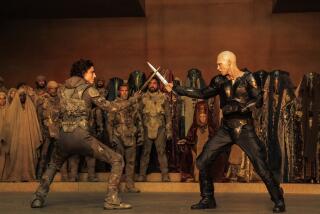Review: Christopher Nolan puts audiences in the middle of WWII in the intimate and epic ‘Dunkirk’
Very much like the pivotal historical event it celebrates, “Dunkirk” confounds expectations. Both intimate and epic, as emotional as it is tension-filled, it is being ballyhooed as a departure for bravura filmmaker Christopher Nolan, but in truth the reason it succeeds so masterfully is that it is anything but.
What happened at the French coastal town of Dunkirk between May 26 and June 4, 1940, was perhaps World War II’s unlikeliest turnaround, as a complete military fiasco transmogrified into a stirring psychological victory capped by Winston Churchill’s stirring “we shall fight on the beaches” speech.
This battle has fascinated writer-director Nolan for years — he once crossed the English Channel on a small boat specifically to get a sense of the setting — and he’s brought a multifaceted examination of it to the screen in a way that’s both structurally daring and evocative of old-school David Lean-style storytelling.
Using a cast that adroitly mixes young actors making their feature-film debuts (including former One Direction member Harry Styles) with canny veterans such as Kenneth Branagh, Cillian Murphy, Mark Rylance and Tom Hardy, “Dunkirk” resembles previous Nolan films like “The Dark Knight” trilogy and “Inception” in concrete as well as thematic ways.
Working with repeat collaborators including cinematographer Hoyte Van Hoytema, production designer Nathan Crowley, editor Lee Smith and composer Hans Zimmer, Nolan demonstrates his all-enveloping skill with the tools of narrative, a deep understanding of and commitment to craft as well as — witness his telling actor Styles that his boots were laced wrong — a willingness to care about the myriad details of filmmaking.
If you don’t see ‘Dunkirk’ on the biggest screen you can find, you’ll be missing the heart of the experience.
Shooting with both Imax and 65mm cameras, some of which were specially designed for small spaces, Nolan not only dazzles us with immersive, God’s-eye perspectives, he understands, as always, that a big screen image pulls you into details like cigarette butts left on a windowsill, that huge close-ups can enhance intimacy and increase immediacy. If you don’t see “Dunkirk” on the biggest screen you can find, you’ll be missing the heart of the experience.
FULL COVERAGE: Golden Globes 2018
As he’s said in numerous interviews, Nolan has conceived of his film not as a historical drama but rather a Hitchcockian thriller where, aided and abetted by Smith’s razor cutting and Zimmer’s crescendoing score, clocks are relentlessly ticking on any number of fronts.
And though much has been made about “Dunkirk” being Nolan’s first film about historical events, on examination that feels like a distinction without a difference. Almost all of his films, even the Batman ones, can be looked at as involving ordinary people being thrust into extraordinary circumstances. That is the case with a vengeance here.
Because of the complexity of what happened at Dunkirk, Nolan has divided his film into three distinct but interlocking narratives, intercutting between actions on the ground, on the sea and in the air — and making it all fit into a crisp 1 hour and 47 minutes.
Though Dunkirk was an enormous event, with close to 400,000 British and Allied troops trapped on that French beach with the Germans about to pounce, Nolan has concentrated on small groups of men whose stories stand in for the larger whole.
What keeps “Dunkirk” from being completely straightforward is a kind of temporal sleight of hand. While the action on land unfolds over a week, what happens on sea takes place in a single day and the air battles unfold in a mere hour. By placing these different time frames on an equal footing, “Dunkirk” enlarges our experience and keeps us on our toes.
It’s the land war we encounter first, watching Tommy (Fionn Whitehead) running for his life as German bullets pursue him though deserted streets. Suddenly the vastness of the Dunkirk beach, as surreal as a Di Chirico landscape, opens up in front of him. (Nolan shot on the real location, which was swept for unexploded ordnance as a precaution).
The land part of “Dunkirk” is called “the mole,” another word for the beach’s stone breakwater with a wooden pier built onto it where long lines of troops are waiting patiently to be evacuated.
Tommy and the other impossibly young soldiers he meets, including the quiet Gibson (Aneurin Barnard) and the edgier Alex (Styles) employ a range of stratagems in their desperation to get on a ship that will take them home. But because safe places can become deathtraps in a heartbeat, feeling secure and out of danger as German planes periodically attack with bullets and bombs is not in the cards.
READ MORE: How Fionn Whitehead went from washing dishes to starring in Christopher Nolan’s ‘Dunkirk’
While the soldiers are young and not really sure what is going on, older and wiser heads fill us in, primarily Navy Commander Bolton, finely done by a gimlet-eyed Kenneth Branagh decades past his own young hero days as Henry V.
It is Bolton who explains that because of the shallow nature of Dunkirk’s beach, small vessels would be needed to rescue the men. A call had gone out to Britain’s boat owners to help, and in fact hundreds of self-motivated small ships (a dozen of the real craft appear in the film) took up the task.
Among those is the Moonstone, owned and piloted by a man named Dawson (Mark Rylance, letter-perfect as always). With him is his son Peter (Tom Glynn-Carney) and his son’s friend George (Barry Keoghan), but their task is complicated when they pick up a shell-shocked survivor who wants only to go home (Nolan veteran Cillian Murphy).
The most exhilarating “Dunkirk” episodes, not surprisingly, are the aerial battles fought against the Germans by a trio of Spitfires. The aerial panoramas cinematographer Van Hoytema and his crew capture are truly dizzying, and having Tom Hardy, an actor whose presence makes the most of confining spaces, as one of the pilots is a major bonus.
Although tension about who will live and who will die is always front and center in a film like this, one of the confounding things about “Dunkirk” is that behind the scenes Nolan and company are quietly building a surprising amount of emotion. By the close, just like those of the troops that did survive, we’re taken unawares by how moving what we’ve been through has been.
For the surpassing accomplishment of “Dunkirk” is to make us feel an almost literal fusion with its story. It’s not so much that we’ve seen a splendid movie, though we have, but as if we’ve been taken inside a historic event, become wholly immersed in something real and alive. Like a debacle turned into a triumph, that is something that doesn’t happen every day.
‘Dunkirk’
Rating: PG-13, for intense war experience and some language
Running time: 1 hour, 47 minutes
Playing: In general release
See the most-read stories in Entertainment this hour »
Movie Trailers
More to Read
Only good movies
Get the Indie Focus newsletter, Mark Olsen's weekly guide to the world of cinema.
You may occasionally receive promotional content from the Los Angeles Times.







